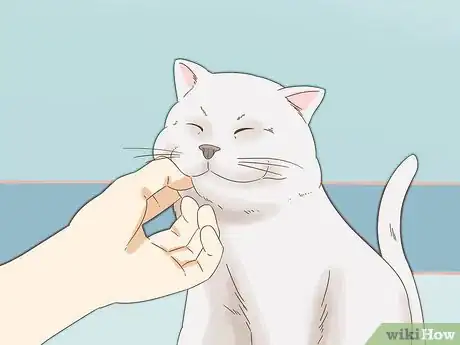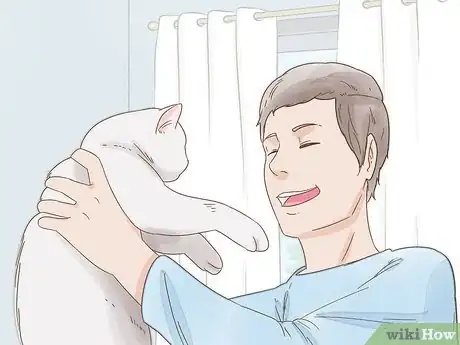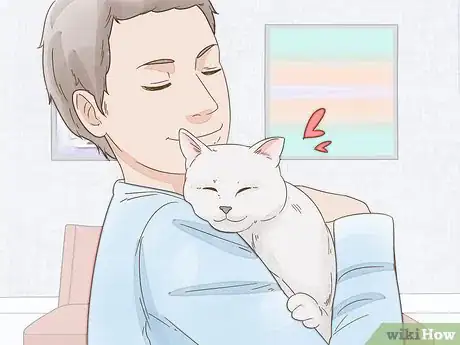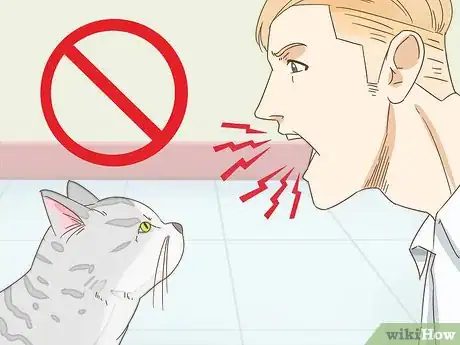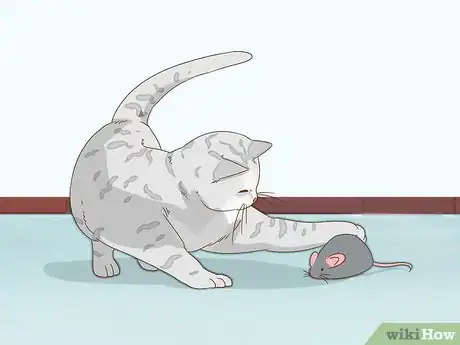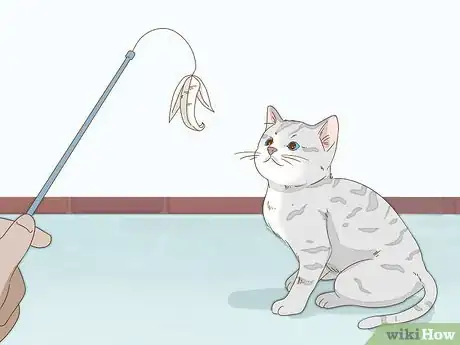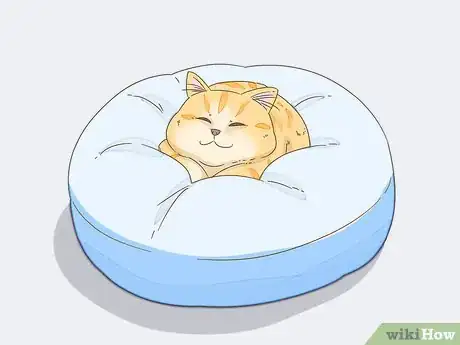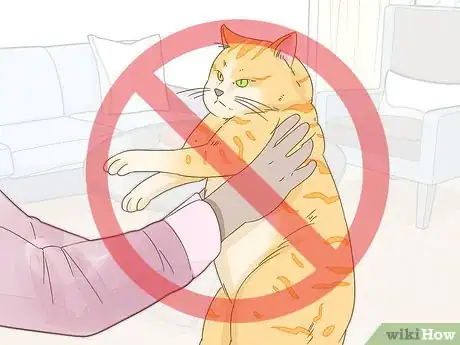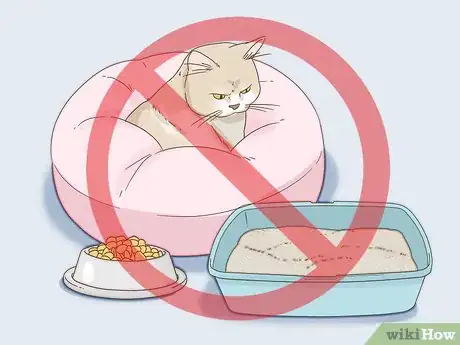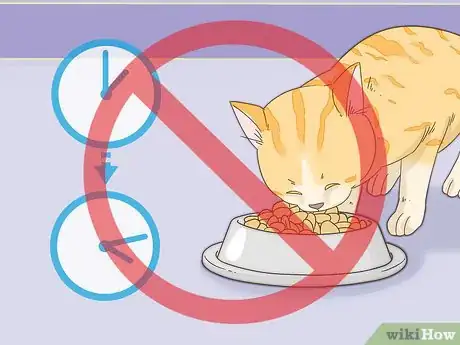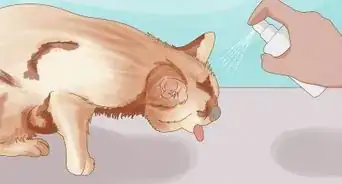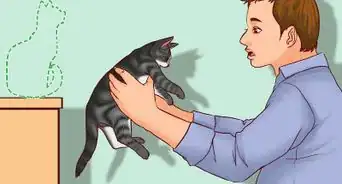This article was co-authored by Pippa Elliott, MRCVS. Dr. Elliott, BVMS, MRCVS is a veterinarian with over 30 years of experience in veterinary surgery and companion animal practice. She graduated from the University of Glasgow in 1987 with a degree in veterinary medicine and surgery. She has worked at the same animal clinic in her hometown for over 20 years.
There are 7 references cited in this article, which can be found at the bottom of the page.
This article has been viewed 87,185 times.
It’s so pleasant when your cat purrs to express contentment. Purring can even have healing benefits for a cat’s human companions. For example, it can lower your stress and even reduce your blood pressure.[1] Encourage your cat to purr by making it comfortable, keeping it happy and reducing its stress, and showing it affection.
Steps
Being Affectionate with Your Cat
-
1Pet your cat. Pet your cat when it approaches you. Never corner the cat or force its attention to you. Stroke the cat under its chin, on its back, or behind its ears. Rub it methodically and gently or knead its fur. Do not pet your cat’s stomach unless you know it likes this.
- If your cat is reluctant to get near you, keep some treats in a pocket and from time to time drop one on the floor, so the cat associates you with tasty treats.
-
2Talk to your cat gently. Use soothing words. You can even purr a little yourself. Repeat sounds or even sing it a lullaby. Avoid staring at the cat as this is a sign of aggression in cat language.Advertisement
-
3Cuddle with your cat. Sit with your cat on your lap whenever you can. Hold it and pet it when you’re on the couch. Lie next to it while it rests in the sun and give it a cuddle. If your cat enjoys cuddling, snuggle with your cat whenever you carry it.
Keeping Your Cat Happy
-
1Spend time with your cat. Interact positively with your cat every day. For example, take some time to hold it. Some cats will purr if you scratch them around the neck. You can even sleep with your cat to give you more time together.[2]
-
2Don’t yell at your cat. Do not punish it because a stressed cat will not purr. Instead of punishing your cat, encourage it through positive reinforcement. For example, praise it consistently when it does things correctly.[3]
-
3Stimulate your cat. Try to provide an environment that lets it perform natural cat behaviors, like hunting, climbing, and hiding. Give your cat perches and opportunities to climb. And give it toys that look or act like prey so it can practice hunting. Cats also need to use their claws, so provide it with a scratching post.[4]
- Hide treats or catnip for it to find.
-
4Play with your cat. Get a laser light, some yarn, or feathers on a string and let your cat pounce on these. Keep the items moving so they simulate prey. Roll items to your cat and it will roll them back to you. You can even try playing fetch.[5]
- Give your cat items to investigate, like balls of aluminum foil or paper towel and toilet paper rolls that it can also bat around.
- Crinkle up some wrapping paper for it to play with.
Making Your Cat Comfortable
-
1Give your cat soft, comfortable places to rest. Help your cat relax by giving it warm, secure places to rest. Make sure it won’t be disturbed in these places for resting. If you feel comfortable with it, let your cat up on the couch or bed, or give it high perches where it can rest and relax.[6]
- Keep window shades open so your cat can lie in the sunshine.
-
2Give your cat space. Allow your cat to roam and play and do not cramp it. For example, do not hold your cat if it resists being held. Also encourage other people in your home to let it be if it doesn’t want to be held. Your cat will feel happier and more secure if it has some freedom.
-
3Keep its environment pleasant. Place your cat’s food, rest areas, and litter box in different places in your home. Cats don’t enjoy eating or relaxing too close to the litter box. And provide your cat with several scratching posts, resting places, and perches throughout your home to enliven its environment.
- Try scenting the air with lavender to make your home more calming and pleasant for your cat.
-
4Don’t make abrupt changes. Make gradual changes in your home or in your cat’s routine. For example, move the furniture in stages rather than rearranging it all at once. Or if you need to change the time when you feed your cat, start by setting the time back or forward in minute increments, rather than by hours. Gently expose your cat to any new animals or people in its life, like a new baby or a new pet.[7]
- Keep new routines consistent after you make any changes.
References
- ↑ http://mentalfloss.com/article/63725/healing-power-cat-purr
- ↑ http://www.womansday.com/life/pet-care/a52231/spend-more-time-cuddling-with-your-cats/
- ↑ http://www.pethealthnetwork.com/cat-health/cat-behavior/how-can-you-reduce-your-cats-stress-home
- ↑ https://icatcare.org/advice/making-your-home-cat-friendly
- ↑ http://www.humanesociety.org/animals/cats/cat_problem_solver/stress.html
- ↑ https://indoorpet.osu.edu/cats/basicneeds/restingareas
- ↑ http://www.dailymail.co.uk/sciencetech/article-3134837/Is-cat-stressed-Study-reveals-spot-pet-unhappy-purring-again.html
About This Article
To make your cat purr, stroke it under the chin, on its back, or behind the ears when it approaches you. As you pet your cat, talk to it gently with soothing words and sounds. Throughout the day, encourage your cat to purr by praising and petting it whenever it does something correctly. Additionally, make your cat feel happy and secure by providing toys, treats, and a comfortable place to rest when it wants to be alone. For more advice from our Veterinary reviewer, including how to make your home a calm and pleasant environment for your cat, keep reading.
